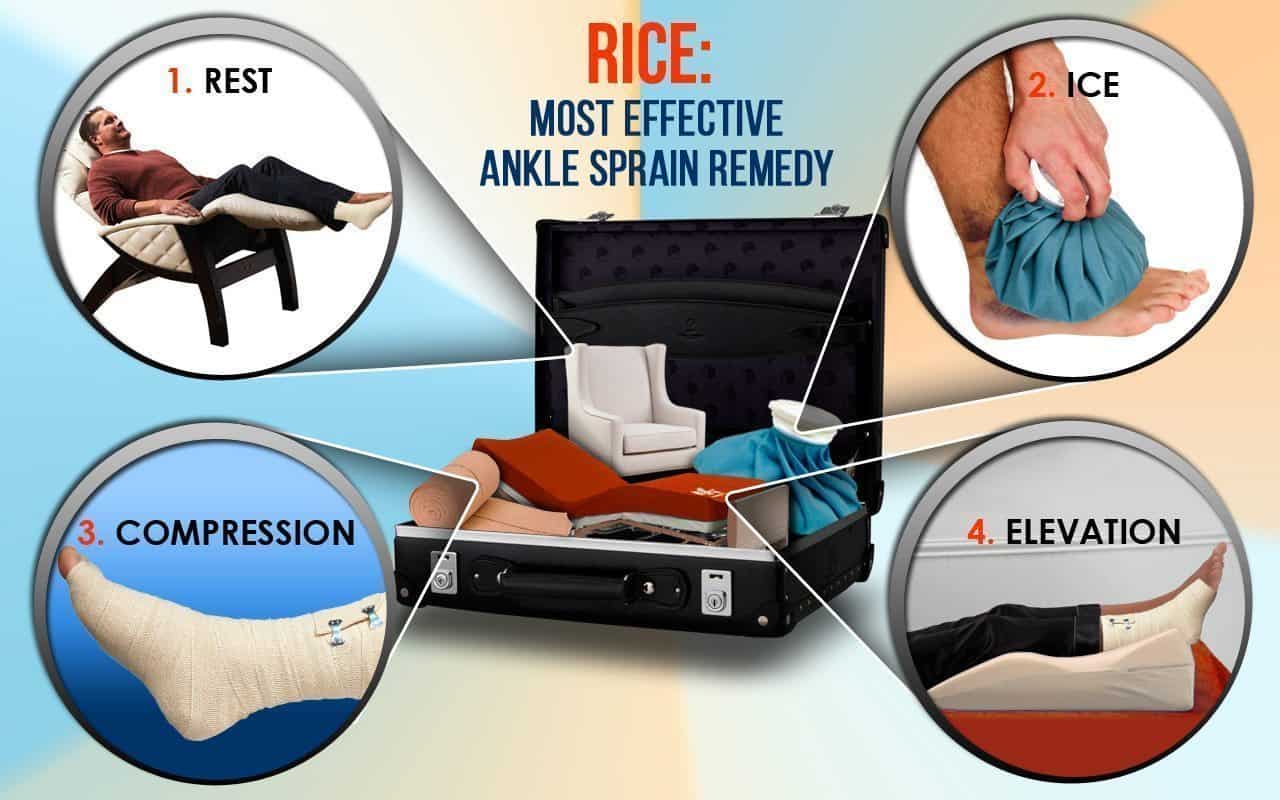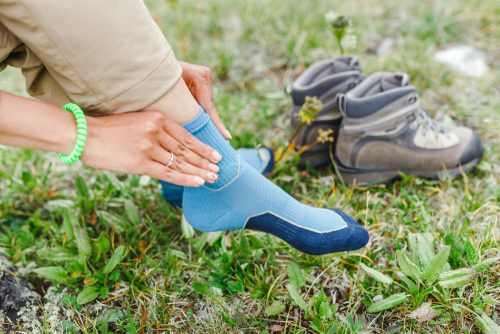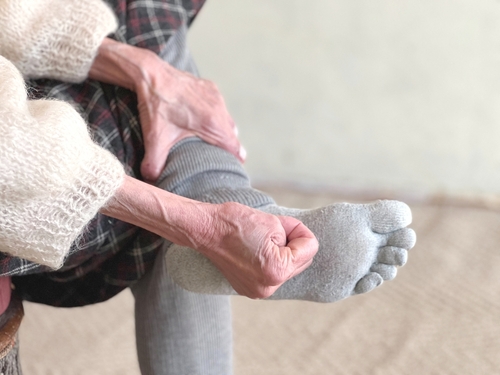
Method for RICE Sprained Ankle – Ankle sprains are a common injury that can occur during various physical activities or even by simply taking an awkward step. When the ligaments that support the ankle joint are stretched beyond their limits or tear, this can result in a sprained ankle. Pain and swelling are typical symptoms and, if left untreated, can lead to long-term complications that may affect one’s mobility and quality of life.
To treat an ankle sprain effectively, the RICE method – which stands for rest, ice, compression, and elevation – is often recommended. This method is particularly effective during the first 48 hours following an injury to reduce pain, ease and reduce swelling, and help the affected individual return to their normal activities as soon as possible.
However, it is always advised to consult a healthcare professional for more severe injuries to ensure proper care is provided.
An ankle sprain is a common injury that occurs when the ligaments that support the ankle joint are stretched or torn. It usually happens when the foot twists or rolls inward, causing the ligaments on the outer side of the ankle to overstretch or tear. As someone experienced in this field, I’ve seen various types of sprains and their severity levels.
In most cases, ankle sprains result from a sudden twisting movement, which can be caused by an unexpected change in footing, stepping on uneven surfaces, or participating in sports activities where quick pivots or jumps are required.
Ligaments are the strong, fibrous bands of tissue that connect bones and provide stability to joints. When a sprain occurs, it’s typically due to an excessive force being applied to these ligaments, causing them to stretch beyond their normal range of motion.
Strains and sprains are often used interchangeably, but they refer to different types of soft tissue injuries. While a sprain involves ligaments, a strain affects muscles or tendons. Regardless of whether you’re dealing with a sprain or strain, the symptoms and treatment options can be quite similar.
Ankle sprains are graded based on their severity, and the treatment approach depends on the specific circumstances. Grade I sprains are mild, with slight stretching and minimal damage to the ligaments. Grade II sprains involve a partial tear, resulting in moderate pain, swelling, and limited range of motion.
Lastly, grade III sprains are severe and characterized by a complete tear, significant pain and swelling, and inability to bear weight on the injured ankle. When faced with an ankle sprain, it’s essential to see a healthcare provider for a proper evaluation. They’ll help assess the extent of the injury and recommend the best treatment plan for your specific needs.
In many cases, the RICE method is recommended as an initial treatment strategy to reduce pain and swelling, promote healing, and restore function to the affected ankle. However, depending on the severity of the injury, additional interventions like immobilization, physical cold therapy, or surgery may be necessary.
I’ve experienced ankle sprains before, and it’s important to recognize the symptoms early on to ensure proper treatment. The most common symptom of an ankle sprain is pain. The severity of the pain depends on the extent of the injury. Mild sprains may cause slight discomfort, while more severe sprains may result in intense pain that can make it difficult to even bear weight on the injured ankle.
Another symptom that is very common with ankle sprains is swelling. This typically occurs as your body’s natural response to the injury, trying to protect and heal the affected area. The amount of swelling can vary based on the severity of the sprain.
Numbness may also be a sign of an ankle sprain. This can happen when the swelling presses on nerves around the injured ligaments, leading to a temporary loss of sensation. In some cases, this numbness can be accompanied by tingling sensations as well.
Bruising is another possible symptom that may occur after an ankle sprain. Damage to the blood vessels in the area can cause blood to leak into the surrounding tissue, resulting in a bruise. The bruise can initially appear as a reddish or purple mark that later changes to yellow or green as it begins to heal.
In case of throbbing pain in a sprained ankle, it could be due to the increased blood flow to the injured area as part of the body’s healing response. This can also contribute to the swelling and tenderness around the ankle.
As the injury begins to heal, it’s possible to notice increased pain when trying to put weight on the ankle or moving it in certain directions. This is normal and should subside as the healing process continues.
In case of severe pain that doesn’t seem to be improving, it would be best to consult a medical professional. This could indicate a more serious injury or complications in the healing process. Always remember to follow the RICE method for treating ankle sprains and seek professional advice if the pain becomes too severe.
As someone experienced in dealing with ankle sprains, I can confidently attest to the effectiveness of the RICE method, which stands for Rest, Ice, Compression, and Elevation. It’s a straightforward protocol to follow in the early stages of injury, and it can help minimize pain, swelling, and overall recovery time.
When starting the RICE method, the first thing to do is rest. Stop any physical activity involving your injured ankle and protect it from further damage. It’s important to give your body time to heal and avoid making the sprain worse by overusing the injured area.
Next, apply ice to reduce pain and swelling. Use an ice pack wrapped in a towel to avoid direct contact with the skin, which could cause an ice burn. Apply the ice for 10 to 20 minutes several times a day during the first 48 hours after the injury. This step helps numb the affected area and restricts blood flow, reducing inflammation and aiding recovery.
Compression is another key component of the RICE method. Wrap the injured ankle with a compression bandage (like an elastic bandage) to help decrease swelling and provide support. When wrapping an ankle, ensure not to wrap it too tight, as this could impair circulation.
Finally, elevate the injured ankle above the level of your heart. Do this by propping your leg up on pillows when sitting or lying down, which helps minimize swelling and pooling of blood in the injured area. This position also promotes blood flow away from the injury, allowing the body to focus on healing.
Using the RICE method, ankle sprains heal faster, and you can return to your daily activities more quickly. By being consistent and diligent in following these steps, individuals can minimize pain and swelling while maximizing the recovery period.

After spraining your ankle, you need to focus on giving it the necessary rest. It is crucial that to avoid putting any weight or stress on the affected area to allow for proper healing. Moving a sprained ankle can further aggravate the injury and prolong the recovery process. Therefore, restrict any movement that might worsen your condition.
Immobilization plays a vital role in the healing of a sprained ankle. A cast or splints can help in providing the much-needed support to the injured area. By immobilizing the ankle, ensure that it remains in a stable position, reducing the chances of further damage.
To avoid weight bearing and movement, resort to using crutches or a cane. These aids help in maintaining balance and mobility while taking the pressure off of the sprained ankle. Although it might be challenging to adapt to their use initially, they are essential to safe recovery.
In addition to immobilization, it is also important to take sufficient breaks during the day to allow your ankle to rest. Do not be tempted to resume normal activities too soon, as doing so can compromise the healing process.
The application of ice is crucial for reducing inflammation and alleviating pain. When preparing to ice an injured ankle, ensure you have an ice pack or a cold pack handy. In a pinch, a bag of frozen vegetables can also work.
When applying the ice pack, always be cautious to avoid direct contact with the skin as it may cause ice burns or frostbite. To prevent this, wrap the ice pack in a towel or a cloth before placing it on the affected area. The barrier serves to protect the skin while still allowing the cold temperature to penetrate for proper healing.
It’s important for to remember not to overdo the icing. In most cases, apply the cold pack for 20-minute intervals and then give the ankle a break for at least 30 minutes to an hour. This process can be repeated several times throughout the day, especially during the first 48 hours following the injury.
In my experience, the consistent, careful use of ice application has proven to be an effective component of the RICE method for treating an ankle sprain. By regularly applying an ice pack, you will notice decreased swelling and increased comfort while the ankle begins to heal. Overall, the ice application step is an essential part of a successful recovery process.
As a part of the RICE method for treating ankle sprains, compression plays an essential role in managing swelling and promoting healing. In this section, I’ll discuss the importance of compression as well as various techniques to ensure effective application.
First, it’s important to understand the goal of compression. When you compress an injured ankle, it helps to limit the blood and plasma flow to the area, which in turn reduces swelling and pain. Compression also provides support to the injured ligaments, allowing them to heal properly.
To properly compress the injured ankle, use an elastic bandage, commonly known as an Ace bandage. It’s important to start wrapping the bandage at the toes and work my way up the ankle for most effective results.

During the process, make sure that the compression is snug but not too tight, as excessive tightness can hinder circulation and slow down the healing process. To check if the bandage has been applied correctly, press a finger against the skin near the edges of the wrap. If the color returns to normal within 2-3 seconds, it indicates that the compression is just right.
Another popular option is to use a compression wrap or an Ace wrap, specifically designed for injuries like sprains. These wraps are similar to elastic bandages but often come with additional features like adjustable straps and built-in support. This provides a more customized level of compression and support for my injured ankle.
Throughout the healing process, you need to continuously monitor the compression and keep it consistent. Once the ankle is wrapped, avoid any activity that puts strain on the injured area. Moreover, keep the bandage on during the first 48-72 hours after the injury, removing it only when necessary. Remember, compression is just one aspect of the RICE method, and must combine it with rest, ice, and elevation for effective recovery.
As a final note, always remember that individual recovery times and circumstances can vary. If you’re unsure about the proper compression technique or the severity of the sprain, it’s wise to consult a healthcare professional for tailored advice.
In the RICE method for treating an ankle sprain, the last step is elevation. Elevation is a crucial part of the healing process. When elevating an injured limb, it should be raised to or above the heart level. This helps to reduce swelling and promote circulation in the affected area.
After an ankle sprain, ensure you elevate the injured ankle in a comfortable and supportive position. You can use pillows or cushions to achieve the desired elevation. While lying down or sitting, it’s important for to ensure that the ankle is elevated above the heart level. Maintaining this position allows gravity to work its magic and help with fluid drainage from the injured area.
Elevation should be implemented as soon as possible after an injury and maintained consistently throughout the healing process. Keep the ankle elevated as much as possible during the first few days after an injury. Doing so provides the best results in managing swelling and pain.
In combination with rest, ice, and compression, elevating an injured ankle forms a crucial component of the RICE method. By following this strategy, give the ankle the best chance at a speedy and efficient recovery.

When treating an ankle sprain with the RICE method, consider medication and pain management as an important step to help in the healing process. Pain relievers and anti-inflammatory medications can provide relief and reduce inflammation, making it easier to move around and continue with your daily activities.
You can choose over-the-counter (OTC) nonsteroidal anti-inflammatory drugs (NSAIDs) like ibuprofen, naproxen, or aspirin to help manage the pain and swelling associated with an ankle sprain. These medications not only alleviate pain but also help in reducing inflammation and promoting healing.
While taking NSAIDs, make sure to follow the recommended dosages and instructions on the label, as excessive use can lead to stomach upset or other side effects. In case OTC medications are not providing sufficient relief, consulting a healthcare professional for a prescription-strength pain reliever is always an option.
Additionally, try to elevate the affected ankle whenever possible to help manage pain and swelling. This can be done by placing a pillow under the foot while resting or sleeping. Keeping the ankle elevated can prevent blood from pooling in the area and help reduce inflammation.
In conclusion, combining the RICE method with appropriate medication and pain management is crucial for when dealing with an ankle sprain. This approach helps recover more quickly and comfortably.
After using the RICE method to treat an ankle sprain, it’s essential to take the next step in recovery with physical therapy and exercise. I believe that incorporating exercises and stretches to restore mobility, flexibility, and strength is crucial in preventing future injuries.
One of the first things I recommend doing after an ankle sprain is gently stretching the affected area to regain range of motion. Slow ankle rolls, both clockwise and counterclockwise, can help increase mobility and ease any stiffness in the joint. Toe raises and heel raises can target the muscles surrounding the ankle, helping to strengthen the area and promote stability.
As you regain strength in the ankle, incorporate more challenging exercises to help build muscle and reinforce stability. Single-leg balance exercises can be beneficial in improving ankle stability and lower body strength. Walking on uneven surfaces helps strengthen the muscles in the legs and ankles and improves overall balance.
When it comes to working on the knee and the surrounding muscles in your leg, focusing on quadriceps and hamstring stretches can significantly help with overall stability. These stretches can be done in various positions, such as sitting, standing, or lying down. In addition to stretching, strengthening exercises for the quads and hamstrings, such as lunges and leg curls, can help reinforce knee stability.
Physical therapy is a great way to receive personalized and targeted rehabilitation for an ankle sprain. A professional therapist can guide you through exercises and stretches designed specifically to address your needs, ensuring that you are on the right track to full recovery. Physical therapists can also monitor progress and adjust the treatment plan as required.
Learn more from this popular post: Top 7 Effective Ankle Strengthening Exercises

After following the RICE method for an ankle sprain, it is important to focus on the healing process and recovery. In my experience, taking the necessary steps to protect the injured ankle and seeking proper medical care can make a significant difference in the healing time and overall outcome of the injury.
In order to facilitate the healing process, continue applying ice to the affected area for a few days after the injury. Using an ice pack or ice slush bath for 15 to 20 minutes and repeating this every two to three hours while awake can help reduce pain and swelling.
During the recovery period, it’s crucial to gradually introduce gentle stretching and movement to the injured ankle. This helps maintain muscle strength and flexibility, as well as promoting blood circulation to the area, which may aid in faster healing. Gentle ankle stretches can be performed by moving the ankle in all directions, without causing discomfort or pain.
It is also wise to consult with a healthcare provider throughout the healing process. They can offer guidance on how to best care for the injury and assess when it may be appropriate to resume normal activities. It is important not to rush back into daily routines or sports, as doing so can lead to re-injury or complications.
In summary, focusing on the healing process and recovery after an ankle sprain is crucial for protecting the injured area, maintaining strength and flexibility, and ensuring a safe return to normal activities. Engaging with a healthcare provider during this time can offer valuable guidance and assistance in navigating through the post-treatment care journey.
When dealing with an ankle sprain and using the RICE method, it’s important to be aware of some possible complications. I want to outline a few of these issues that may arise.
First, there’s a risk of misdiagnosing a more severe injury, such as a fracture or broken bones. If you suspect a fracture, it is crucial to seek medical attention. A proper diagnosis is essential for appropriate treatment and recovery.
Secondly, persistent pain and swelling might occur despite applying the RICE method. If the pain does not subside within a reasonable period, this could indicate a more severe injury that requires professional care. It is vital to consult with a healthcare professional in such cases.
Additionally, complications may arise if surgery is needed. While not common for mild ankle sprains, severe cases might require surgical intervention. Surgery carries risks, such as infection, nerve damage, and blood clots. Again, consulting with a healthcare professional is crucial to discuss potential risks and benefits.
Lastly, improper execution of the RICE method could lead to further complications. It’s essential to follow the steps accurately to avoid causing more harm and ensure a proper recovery process.
In summary, while RICE is beneficial for managing mild ankle sprains, it’s critical to be aware of potential complications and seek medical advice when necessary.

One of the most effective ways to prevent future ankle sprains is to ensure proper warm-up before engaging in any physical activity. Always spend at least 10 minutes warming up your muscles and joints to increase flexibility and blood flow through blood vessels to the area. This can significantly reduce the risk of a sports injury.
Another measure to prevent sprains is wearing ankle braces during activities that put stress on the ankles, such as running or playing basketball. These braces provide additional support to the ankle joint, helping to prevent injuries.
It’s also crucial to maintain good flexibility in the muscles and ligaments surrounding the ankle, as this can help prevent sprains. I make sure to regularly stretch my calf muscles, Achilles tendon, and the muscles on the outer side of my ankle. This ensures that the joint can move through its full range of motion, reducing the likelihood of a sprain.
By incorporating these preventative measures into your routine, you will significantly reduce the risk of future ankle sprains and enjoy your favorite physical activities with confidence.
Also read: An Effective Ankle Sprain Remedy
The RICE method is a popular approach for treating ankle sprains and other soft tissue injuries. It stands for Rest, Ice, Compression, and Elevation. This method aims to reduce inflammation, alleviate pain, and promote recovery. I recommend this strategy to help manage the symptoms and support healing.
For Rest, it’s crucial to give your ankle enough time to heal, which could range from a few days to several weeks, depending on the severity of the sprain. Ice should be applied for 15-20 minutes every hour on the hour until the swelling goes down.
Compression with an elastic bandage or wrap should be firm but not too tight and can be used throughout the day for the first few days or as needed. Lastly, Elevation should be performed as often as possible to help reduce swelling, ideally above the level of your heart, especially during the first 48 hours.
There are alternatives to the RICE method, such as the MEAT (Movement, Elevation, Analgesia, and Treatment) approach. This method emphasizes the importance of early movement and therapeutic techniques to promote a more rapid recovery.
Another option is the POLICE method (Protection, Optimal Loading, Ice, Compression, Elevation), which focuses on gradually reintroducing weight-bearing and movement to the injured area. It’s best to consult a healthcare professional to determine the most appropriate treatment for your specific injury and individual needs.
I suggest starting the RICE method as soon as possible after experiencing an ankle sprain. Immediate treatment helps control inflammation, reduce pain, and minimize swelling, promoting faster recovery. Adhering to these steps within the first few hours after injury can significantly improve the overall healing process.
Yes, the RICE method can be applied to various soft-tissue injuries, including sprains, strains, bruises, and contusions. By addressing inflammation and promoting healing, this method can be beneficial for managing the symptoms and recovery of many injuries involving tendons, muscles, and ligaments.
While the RICE method is widely accepted and recommended, some potential drawbacks may include excessive rest leading to joint stiffness, loss of strength, and delayed recovery. Additionally, improper icing or compression techniques could potentially cause skin or nerve damage. It’s essential to consult a healthcare professional to tailor the RICE method to the specific injury and ensure appropriate application of the steps.